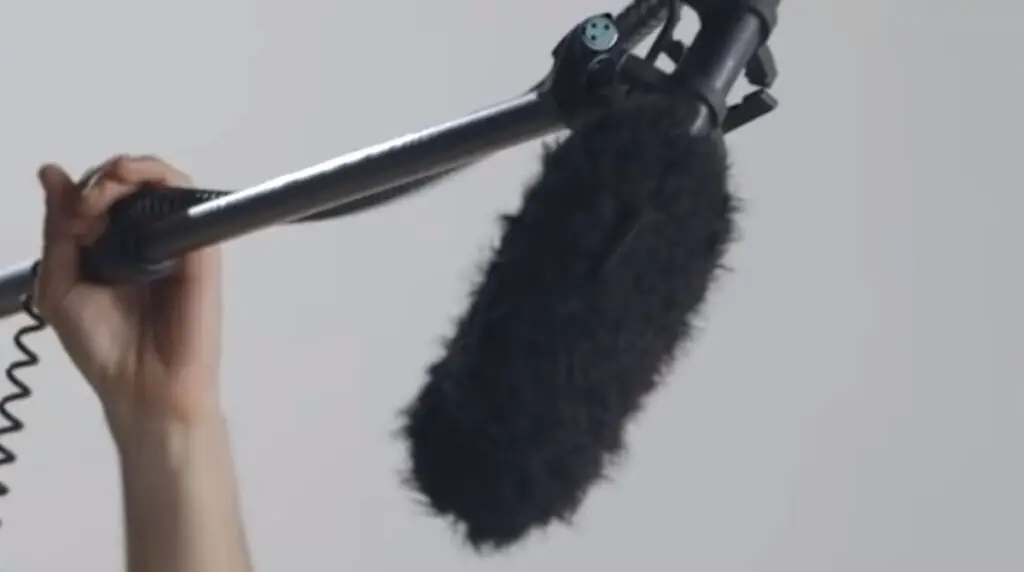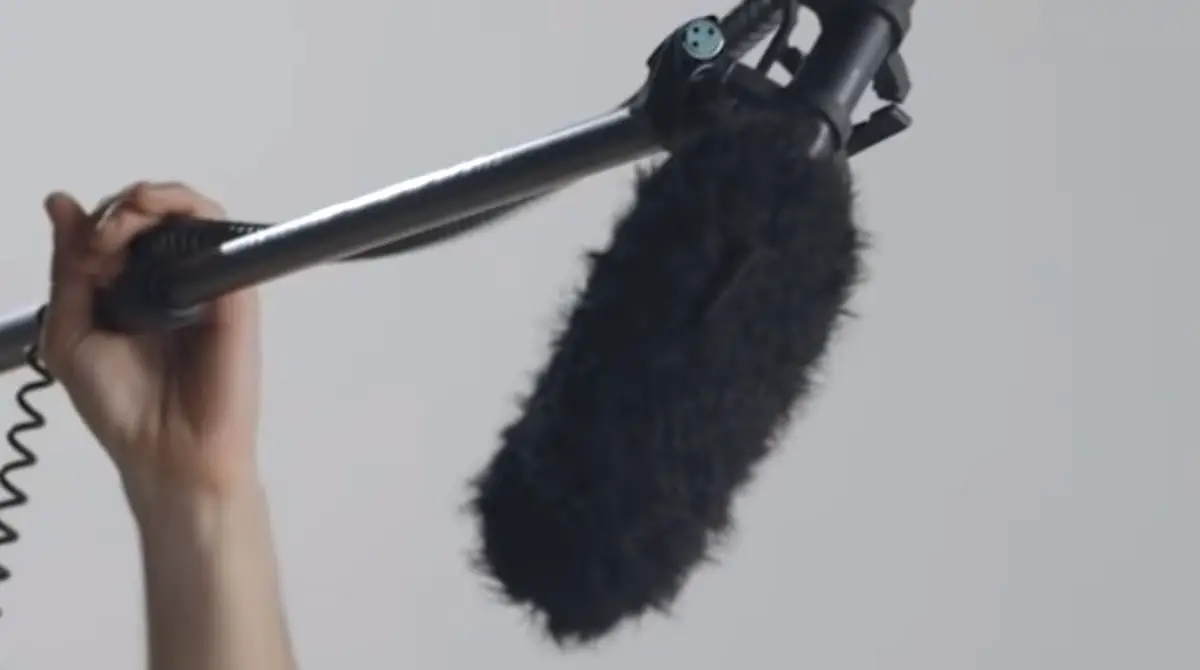In the realm of film and television production, capturing crystal-clear audio is paramount to creating an immersive and professional viewing experience.
Enter the boom microphone, an unsung hero behind the scenes that ensures impeccable sound quality without compromising the visual aesthetics.
What is a boom mic?
A boom microphone is a type of microphone that is mounted on a long arm, or “boom,” allowing it to be positioned close to the sound source without being in the camera’s frame; typically used in film and television production for capturing high-quality audio.
In this article, we talk all about boom microphones, unraveling their purpose, functionality, and the role they play in capturing pristine audio on the set.

What Is A Boom Mic?
A boom microphone, often simply called a “boom mic,”is a directional microphone mounted or attached to a pole or arm, or “boom,” to allow it to be positioned close to the actors or source of the sound without being in the camera’s frame.
This makes it an essential tool in film and television production.
The long boom arm allows the microphone to be held above the actors or scene, out of the camera’s view, while still capturing high-quality audio. The boom can be held and moved manually by an operator, or it can be mounted on a stand or other rigging for static scenes.
The microphone itself is usually a shotgun microphone, which is a type of highly directional microphone. This means it captures sound from a very specific area in the direction it is pointed and is less sensitive to sounds from other directions. This characteristic makes it ideal for isolating dialogue or other specific sounds in a noisy environment.
Here are some of the benefits of using a boom mic:
- It can be positioned close to the sound source without being visible in the shot. This is important in film and television production, where the microphone should not be seen in the frame.
- It can be used to capture sound from a distance. This is useful for recording interviews or capturing ambient sound.
- It can be used to capture sound from multiple sources. This is useful for recording a group conversation or a live event.
Here are some of the drawbacks of using a boom mic:
- It can be difficult to use. The boom operator needs to be skilled in positioning the microphone and avoiding noise.
- It can be expensive. Boom mics can be more expensive than other types of microphones.
- It can be bulky. Boom mics can be large and heavy, which can make them difficult to transport and use.
What Is A Boom Mic Used For?
A boom microphone is primarily used in film, television, and theater production to capture high-quality sound while keeping the microphone out of the camera’s frame or the audience’s view. Boom mics can also be used to amplify a group conversation, as they can be positioned so that everyone’s voice can be heard.
Here are some common uses:
- Dialogue Recording: Boom mics are often used to record dialogue in film and television production. Because the microphone can be positioned close to the actors without appearing in the shot, it can capture clear and direct sound.
- Sound Effects Recording: Sometimes, boom mics are used to capture specific sound effects on set. For example, if a scene involves an actor interacting with an object, a boom mic can be used to capture the sound of that interaction.
- Location Sound: Boom mics can be used to capture the ambient sound of a location. This can be particularly useful in documentaries or other types of location-based filming.
- Live Performances: In theater productions or live performances, boom mics can be used to amplify sound for the audience. They can be strategically placed to capture the sound from the stage without obstructing the view of the performance.
- Podcasting: Boom mics are a popular choice for podcasting, as they can provide high-quality audio without the need for a separate audio interface.
- Interviewing: Boom mics are often used to record interviews, as they can be positioned close to the interviewee without being intrusive.
- Audio recording: Boom mics can be used for any type of audio recording, such as music, voice-overs, and narration.
The type of microphone attached to the boom arm can vary depending on the specific needs of the production. As mentioned before, a common choice is a shotgun microphone due to its highly directional pickup pattern, which allows it to isolate the sound it’s pointed at from other background noise.
What Is The Difference Between A Boom Mic And A Regular Mic?
The main difference between a boom microphone and a regular microphone is their application and design. A boom mic is typically mounted on a pole or arm, which allows it to be positioned close to the sound source without being visible in the shot. A regular mic, on the other hand, is typically held or placed on a stand, which limits its mobility.
A “regular” microphone often refers to a handheld or stand-mounted microphone used for a wide range of applications, like singing, podcasting, broadcasting, etc.
On the other hand, a boom microphone is commonly used in video and film production, where it’s crucial to capture high-quality sound without the microphone appearing in the frame.
Here are some key differences:
- Placement and Use: A regular microphone is usually placed in front of the person or sound source, and it may appear in the frame (like in an interview or podcast). A boom microphone, however, is mounted on a long arm (the “boom”) and held above or to the side of the sound source, out of the camera’s frame.
- Microphone Type: A regular microphone can be of various types like dynamic, condenser, ribbon, etc., each with its characteristics and ideal use cases. A boom microphone often uses a “shotgun” microphone, which is a type of condenser mic with a highly directional pickup pattern. It’s designed to capture sound from a specific area while rejecting sounds from the sides and rear.
- Sound Quality: While both types of microphones can provide high-quality sound, the boom microphone’s placement allows it to capture clearer dialogue or specific sound effects in a scene, reducing the amount of ambient or background noise.
- Mobility: Boom microphones can be moved dynamically during a shoot to follow the action or dialogue, while regular microphones are typically stationary.
Here is a table that summarizes the key differences between boom mics and regular mics:
| Feature | Boom Mic | Regular Mic |
| Polar pattern | Directional | Omnidirectional or cardioid |
| Mounting | Pole or arm | Stand or handheld |
| Use cases | Film and television production, live events, podcasting, interviewing, audio recording | Studio recording, live performance, voice-overs, narration |
| Pros | Can be positioned close to the sound source without being visible, can be used to capture sound from multiple sources | Easy to use, portable, affordable |
| Cons | Can be difficult to use, bulky, expensive | Can pick up unwanted noise, not as effective at capturing sound from multiple sources |
What’s The Difference Between A Shotgun Mic And A Boom Mic?
The terms “shotgun mic” and “boom mic” often get used interchangeably, but they refer to different aspects of a sound recording setup.
A boom mic is any microphone that is mounted on a boom, which is a long pole or arm that allows the microphone to be positioned close to the sound source without being visible in the shot. A shotgun mic is a specific type of directional microphone that is often used on boom mics.
- Shotgun Mic: This term refers to a type of microphone. Shotgun microphones have a highly directional or “super-cardioid” pickup pattern, meaning they capture sound primarily from the direction they are pointed in and reject sound from the sides and rear. This makes them ideal for isolating specific sounds or voices in a noisy environment. They are often long and cylindrical in shape, resembling a shotgun barrel, hence the name.
- Boom Mic: This term refers to how a microphone is mounted or positioned. A boom mic is any microphone (including a shotgun mic) that is attached to a boom pole or boom arm. The boom allows the microphone to be positioned close to the sound source while staying out of the camera frame or the audience’s view.
So, a shotgun mic can be used as a boom mic by mounting it on a boom pole. In film and TV production, this is a common setup because it combines the benefits of the shotgun mic’s directional pickup pattern with the boom’s flexible positioning.
It’s also possible to use other types of microphones as boom mics if the situation calls for it.
Here is a table that summarizes the key differences between shotgun mics and boom mics:
| Feature | Shotgun Mic | Boom Mic |
| Polar pattern | Highly directional | Directional |
| Capsule | Typically uses a supercardioid or hypercardioid capsule | Can use any type of capsule |
| Mounting | Typically mounted on a boom | Can be mounted on a boom, stand, or handheld |
| Use cases | Film and television production, live events, podcasting, interviewing, audio recording | Film and television production, live events, podcasting, interviewing, audio recording |
| Pros | Excellent rejection of off-axis noise, can be positioned close to the sound source without being visible | Versatile, can be used in a variety of applications |
| Cons | Can be difficult to use, bulky, expensive | Can pick up unwanted noise, not as effective at capturing sound from multiple sources |
Conclusion
The boom microphone stands as a silent guardian on film and television sets, enabling the seamless capture of high-quality audio that enhances the viewer’s immersion and engagement.
Its ability to position the microphone close to the sound source while remaining invisible to the camera ensures a harmonious balance between visuals and audio.
As we reveal the significance of the boom microphone, we gain a deeper appreciation for its indispensable role in delivering captivating storytelling.
So, let the boom microphone continue to elevate the art of sound recording, forever enhancing our on-screen experiences with its unwavering precision.

